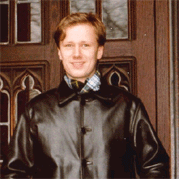A researcher from the University of California Riverside takes pictures of the movement of molecules at time intervals of a billionth of a second
University of California Riverside

Ludwig Bartels. Credit: UCR
Direct address to this page:
https://www.hayadan.org.il/molpics0804.html
A new method allows scientists to get to the bottom of fundamental questions in the surface science of materials.
A team of researchers, including Ludwig Bartels, professor of chemistry at the University of California Riverside, developed a method for taking extremely fast pictures of the movement of atoms and molecules. The new development is considered a serious advance in the field of material surface science, a field that studies the chemical reactions that occur on the surface of solids.
The results of the study are published in the current issue of the scientific journal Science. In addition, the results were published in the June 15 issue of Science Express. The article, called "Real-Space Observation of Molecular Motion Induced by Femtosecond Laser Pulses" in Hebrew translation, deals with the movement of carbon molecules carbon monoxide on a copper surface, when they are bombarded with extremely fast laser pulses.
"We were able to identify, step by step, the copy of the molecules, which moved at a particularly high speed as a result of femtosecond laser pulses," said Bartels, characterizing the new method as a kind of method for photographing the movement of molecules. Bartels' paper co-authors are Tony P. Heinz, Dietmar Moller and Wang Wang of Columbia University and Ernst Knoesel of Rowan University in Glassboro, New Jersey.
"Scanning microscopes have the ability to reach directly into space on the scale of atoms and molecules," Bartels said. "While femtosecond laser methods have the ability to reach times on the order of atomic events."
"The challenging problem of combining these two capabilities has generated a lot of interest," he added. "Although we have not yet achieved the ultimate goal of true time and space movies, we believe that the present paper represents a very important advance towards combining these two powerful methods."
The new method allows scientists to investigate very basic questions in the surface science of materials, say Bartels and his co-authors of the paper. Among these questions can be found questions, such as what processes on the surface of a material drive the occurrence of the diffusion process on its surface? Diffusion at the surface of a material is a fundamental and important process in material surface science. It has an important role in various processes such as the formation of crystals and the activity of chemical catalysts.
"This is very basic research, but it has implications for many other areas of science," Bartels said. "Catalysts, like the one found in the exhaust system of every car, are made of porous materials. The exhaust gas passes through the porous material, and the pollutants in the gas, such as carbon monoxide and nitrogen monoxide, stick to the surface of the catalyst material."
A small portion of the catalyst surface can, in principle, transform the pollutants into harmless gases, while the rest of the catalyst surface will support these active sites. Understanding the movement of carbon monoxide molecules across the surface of a catalyst material on the way to finding the active sites may eventually lead to the design of more efficient catalysts. The findings of the article offer a new way to study the fastest movements of carbon monoxide across surfaces.
translating:
Dikla Oren
The press release from the University of California Riverside
Physics expert
https://www.hayadan.org.il/BuildaGate4/general2/data_card.php?Cat=~~~917459289~~~95&SiteName=hayadan
